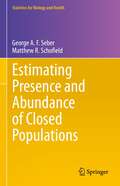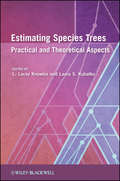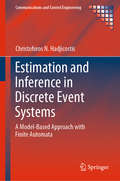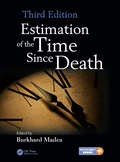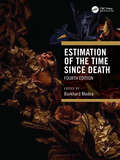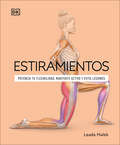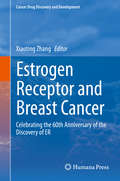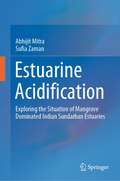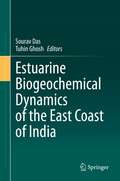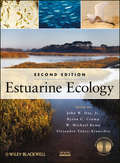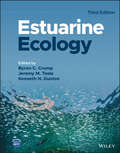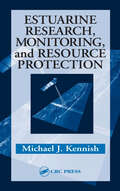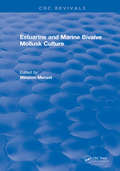- Table View
- List View
Estimating Presence and Abundance of Closed Populations (Statistics for Biology and Health)
by Matthew R. Schofield George A. SeberThis comprehensive book covers a wide variety of methods for estimating the sizes and related parameters of closed populations. With the effect of climate change, and human territory invasion, we have seen huge species losses and a major biodiversity decline. Populations include plants, trees, various land and sea animals, and some human populations. With such a diversity of populations, an extensive variety of different methods are described with the collection of different types of data. For example, we have count data from plot sampling, which can also allow for incomplete detection. There is a large chapter on occupancy methods where a major interest is determining whether a particular species is present or not. Citizen and opportunistic survey data can also be incorporated. A related topic is species methods, where species richness and species' interactions are of interest. A variety of distance methods are discussed. One can use distances from points and lines, as well as nearest neighbor distances. The applications are extensive, and include marine, acoustic, and aerial surveys, using multiple observers or detection devices. Line intercept measurements have a role to play such as, for example, estimating parameters relating to plant coverage. An increasingly important class of removal methods considers successive “removals" from a population, with physical removal or "removal" by capture-recapture of marked individuals. With the change-in-ratio method, removals are taken from two or more classes, e.g., males and females. Effort data used for removals can also be used. A very important method for estimating abundance is the use of capture-recapture data collected discretely or continuously and can be analysed using both frequency and Bayesian methods. Computational aspects of fitting Bayesian models are described. A related topic of growing interest is the use of spatial and camera methods. With the plethora of models there has been a corresponding development of various computational methods and packages, which are often mentioned throughout. Covariate data is being used more frequently, which can reduce the number of unknown parameters by using logistic and loglinear models. An important computational aspect is that of model selection methods. The book provides a useful list of over 1400 references.
Estimating Species Trees
by Laura S. Kubatko L. Lacey KnowlesRecent computational and modeling advances have produced methods for estimating species trees directly, avoiding the problems and limitations of the traditional phylogenetic paradigm where an estimated gene tree is equated with the history of species divergence. The overarching goal of the volume is to increase the visibility and use of these new methods by the entire phylogenetic community by specifically addressing several challenges: (i) firm understanding of the theoretical underpinnings of the methodology, (ii) empirical examples demonstrating the utility of the methodology as well as its limitations, and (iii) attention to technical aspects involved in the actual software implementation of the methodology. As such, this volume will not only be poised to become the quintessential guide to training the next generation of researchers, but it will also be instrumental in ushering in a new phylogenetic paradigm for the 21st century.
Estimating the Impacts of Urban Growth on Future Flood Risk: A Comparative Study (IHE Delft PhD Thesis Series)
by Willem VeerbeekThe unprecedented growth of cities has a significant impact on future flood risk that might exceed the impacts of climate change in many metropolitan areas across the world. Although the effects of urbanisation on flood risk are well understood, assessments that include spatially explicit future growth projections are limited. This comparative study provides insight in the long term development of future riverine and pluvial flood risk for 18 fast growing megacities. The outcomes provide not only a baseline absent in current practise, but also a strategic outlook that might better establish the role of urban planning in limiting future flood risk.
Estimation and Inference in Discrete Event Systems: A Model-Based Approach with Finite Automata (Communications and Control Engineering)
by Christoforos N. HadjicostisEstimation and Inference in Discrete Event Systems chooses a popular model for emerging automation systems—finite automata under partial observation—and focuses on a comprehensive study of the key problems of state estimation and event inference. The text includes treatment of current, delayed, and initial state estimation. Related applications for assessing and enforcing resiliency—fault detection and diagnosis—and security—privacy and opacity—properties are discussed, enabling the reader to apply these techniques in a variety of emerging applications, among them automated manufacturing processes, intelligent vehicle/highway systems, and autonomous vehicles. The book provides a systematic development of recursive algorithms for state estimation and event inference. The author also deals with the verification of pertinent properties such as:the ability to determine the exact state of a system, “detectability”;the ability to ensure that certain classes of faults can be detected/identified, “diagnosability”; andthe ability to ensure that certain internal state variables of the system remain “hidden” from the outside world regardless of the type of activity that is taking place, “opacity”. This book allows students, researchers and practicing engineers alike to grasp basic aspects of state estimation in discrete event systems, aspects like distributivity and probabilistic inference, quickly and without having to master the entire breadth of models that are available in the literature.
Estimation of the Time Since Death
by Burkhard MadeaEstimation of the Time Since Death remains the foremost authoritative book on scientifically calculating the estimated time of death postmortem. Building on the success of previous editions which covered the early postmortem period, this new edition also covers the later postmortem period including putrefactive changes, entomology, and postmortem r
Estimation of the Time Since Death
by Burkhard MadeaEstimation of the Time Since Death remains the foremost authoritative book on scientifically calculating the estimated time of death postmortem. Building on the success of previous editions which covered both the early and later postmortem periods this edition includes a new chapter on DNA/RNA degradation and further new content on drug testing in hair, thus widening the scope of the material. Chapters have been improved, updated and expanded, and include new and additional images to enhance the text. A unique work of synthesis combining rigorous science with practical guidance, this update reinforces the book’s reputation as an invaluable resource – and also the standard – for the estimation of the time since death.
Estiramientos (DK Science of)
by Dr. Leada MalekRelaja tu cuerpo reduciendo la tensión en los músculos y elimina la rigidez en las articulaciones con más de 100 estiramientos.El teletrabajo y el sobreuso de pantallas se ha convertido poco a poco en la nueva normalidad y corremos el riesgo de ser cada vez más sedentarios y perder la funcionalidad muscular. ¿Buscas una solución fácil y eficiente para evitarlo? Con esta guía de estiramientos podrás llevar a cabo una serie de ejercicios variados que te ayudarán a recuperar la movilidad y cuidar tu salud física.Pasa sus páginas y descubre:Más de 100 ejercicios para estirar tus músculos, acompañados de imágenes en 3D, variaciones adaptadas a tus necesidades y toda la información que necesitas para evitar lesiones y evaluar tu progreso.Instrucciones sobre cómo realizar cada ejercicio: cuál es la postura corporal correcta, qué músculos estás trabajando y cómo afectan a los movimientosEntrenamientos adaptados a diferentes habilidades y objetivos, diseñados para que progreses cada semana o cada mes.Basado en las últimas investigaciones sobre los beneficios de los tipos de estiramiento estático, dinámico y FNP (Facilitación Neuromuscular Propioceptiva) y con información sobre cómo integrarlos en tu rutina diaria.Deja atrás las malas prácticas y aprende a estirar tus músculos de manera correcta con Estiramientos, un libro repleto de sesiones de ejercicios, consejos sobre cómo realizarlos de forma segura y calentamientos para mejorar tu rendimiento y lograr tus objetivos con éxito.-------------------------------Loosen tight muscles and stiff joints with over 100 stretches designed to keep you flexible, energized, and pain-free.As working from home becomes the new normal, we risk seizing up, losing muscle functionality, and developing aches and pains from increased sedentary living. Yet, with a regular program of varied stretch workouts, everyone can reach and maintain maximum mobility.Dive straight in to discover:Specially commissioned CGI artworks depict 100 stretch exercises and variations that add or reduce challenge.Artworks detail the mechanics of each exercise, correct body posture, the muscles involved, and how they engage to perform movementsStretch workouts tailored to different abilities and aims provide suggested practices with a progressive increase in challenge over weeks and monthsThe book begins by examining the latest research on the benefits of static, dynamic, and PNF (proprioceptive neuromuscular facilitation) stretching modes. It explains how best to integrate them into your day – and use them safely in a sporting context, alongside warm-ups and exercise sessions, to enhance performance.
Estrogen Receptor and Breast Cancer: Celebrating the 60th Anniversary of the Discovery of ER (Cancer Drug Discovery and Development)
by Xiaoting ZhangThe discovery of ER by Dr. Elwood Jensen exactly 60 years ago has not only led to the birth of a whole new vital nuclear receptor research field but also made a rapid, direct and lasting impact on the treatment and prevention of breast cancer. Since that landmark discovery, tremendous progress has been made in our understanding of the molecular functions of ER and development of targeted therapies against ER pathways for breast cancer treatment. However, there is currently no book available addressing these discoveries and recent advancement in a historical and systematic fashion. This book is intended to provide comprehensive, most up-to-date information on the history and recent advancement of ER and breast cancer by world renowned leaders in the field. These chapters include the history of the discovery of ER; physiological and pathological roles of ER; recent discovery of ER cistrome, transcriptome and its regulation of noncoding RNAs such as microRNAs and enhancer RNAs in breast cancer; development and clinical practices of the first targeted therapy Tamoxifen and other antiestrogens for breast cancer treatment; structural basis of ER and antiestrogen actions; molecular insights into endocrine resistance; the role of ER mutants, ER-beta and environmental estrogens in breast cancer; and emerging state-of-the-art therapeutic approaches currently in development to overcome treatment resistance and future perspectives. The book will provide undergraduate and graduate students, basic scientists and clinical cancer researchers, residents, fellows, as well as clinicians, oncology educators and the general public a thorough and authoritative review of these exciting topics.
Estrogen Receptors: Methods and Protocols (Methods in Molecular Biology #2418)
by Kathleen M. EysterThis fully updated collection includes chapters on a wide array of techniques that are vital for advancing our understanding of the physiological and pathological effects of estrogen, mediated by estrogen receptor α (ERα) and estrogen receptor β (ERβ) as well as the non-genomic membrane-bound G-protein coupled estrogen receptor (GPER/GPR30). The protocols range from standard methods and important laboratory workhorses such as immunoblot and RT-qPCR, to newer technologies such as PET imaging, reporter animal models, polysome fractionation, and many others, involving a broad range of tissue types to demonstrate the variety of estrogen receptor effects. Written for this highly successful Methods in Molecular Biology series, chapters include introductions to their respective topics, lists of the necessary materials and reagents, step-by-step, readily reproducible laboratory protocols, and tips on troubleshooting and avoiding known pitfalls. Authoritative and practical, Estrogen Receptors: Methods and Protocols, Second Edition serves as an ideal guide to researchers working to explore the vibrancy and excitement of the field of estrogen receptors and estrogen actions.
Estuaries of Australia in 2050 and beyond
by Eric WolanskiThe book addresses the questions: Is Australia's rapidly growing human population and economy environmentally sustainable for its estuaries and coasts? What is needed to enable sustainable development? To answer these questions, this book reports detailed studies of 20 iconic Australian estuaries and bays by leading Australian estuarine scientists. That knowledge is synthesised in time and space across Australia to suggest what Australian estuaries will look like in 2050 and beyond based on socio-economic decisions that are made now, and changes that are needed to ensure sustainability. The book also has a Prologue by Mr Malcolm Fraser, former Prime Minister of Australia, which bridges environmental science, population policy and sustainability.
Estuaries: A Lifeline of Ecosystem Services in the Western Indian Ocean
by Salif Diop Peter Scheren John MachiwaThis book provides recent environmental, ecological and hydrodynamic information for the major estuaries and the coastal marine systems of the Western Indian Ocean Region. It covers various functions and values of the region's estuarine ecosystems and their respective habitats, including the land/ocean interactions that define and impact ecosystem services. The Western Indian Ocean region covered by this volume consists of the continental coastal states of Kenya, Mozambique, South Africa and Tanzania and the island states of Madagascar, Mauritius, Seychelles and Comoros.
Estuarine Acidification: Exploring the Situation of Mangrove Dominated Indian Sundarban Estuaries
by Abhijit Mitra Sufia ZamanThis book provides a cross-sectoral, multi-disciplinary assessment of different problems associated with estuarine acidification with special thrust on mangrove dominated Indian Sundarban estuaries. The arms of ocean acidification have extended to coastal and estuarine waters, where a wide spectrum of biodiversity thrives with unique adaptation extending several ecosystem services. Impact of acidification in these areas is a matter of concern as acidification potentially has more immediate effects on the health of estuaries and inshore regions as well as regional economies. Ground zero data collected for more than three decades have made the book stand on a strong base.
Estuarine Biogeochemical Dynamics of the East Coast of India
by Tuhin Ghosh Sourav DasThis book provides a comprehensive overview of recent research on estuaries of the east coast of India, and how changing biogeochemical dynamics as a result of climate change and human activity have impacted estuaries and other open water ecosystems. Though estuaries only cover a very small portion of the earth’s hydrosphere, they are some of the most biogeochemically active regions among the global water bodies. As such, this book focuses on estuaries of the east coast of India going all the way to the Bay of Bengal, which is the world's largest freshwater input from perennial rivers and rain-fed estuaries, and is therefore a unique area of study. Through its unique coverage of the Bay of Bengal in particular, the book presents a new perspective not present in the literature on estuary biogeochemistry and ecosystem dynamics. Moreover, the book addresses SDG 13 (Climate Action) and 14 (Life below Water), with a focus on ecosystem services of the natural aquatic system.The book will be useful to researchers, policy makers, coastal managers and marine sustainability scientists and organizations.
Estuarine Cities Facing Global Change: Towards Anticipatory Governance
by Denis Salles Glenn Mainguy Charles de Godoy LeskiAt the heart of the globalization of trade and of economies, estuarine cities are at the forefront of accelerating global change. They must confront the tensions generated by their demographic and socio-economic attractions and their ecological vulnerability linked to their location in trade flows, downstream of rivers and at the interface between land and sea. Using the examples of the estuarine cities of the Gironde, the Loire and the Seine and their specific challenges, such as climate change, flood risk, biodiversity, port flows and urban planning, this book analyzes their emerging trajectories guided by proactive governance of global change.
Estuarine Ecology
by W. Michael Kemp Alejandro Yáñez-Arancibia Byron C. Crump John W. DayEstuaries are among the most biologically productive ecosystems on the planet--critical to the life cycles of fish, other aquatic animals, and the creatures which feed on them. Estuarine Ecology, Second Edition, covers the physical and chemical aspects of estuaries, the biology and ecology of key organisms, the flow of organic matter through estuaries, and human interactions, such as the environmental impact of fisheries on estuaries and the effects of global climate change on these important ecosystems.Authored by a team of world experts from the estuarine science community, this long-awaited, full-color edition includes new chapters covering phytoplankton, seagrasses, coastal marshes, mangroves, benthic algae, Integrated Coastal Zone Management techniques, and the effects of global climate change. It also features an entriely new section on estuarine ecosystem processes, trophic webs, ecosystem metabolism, and the interactions between estuaries and other ecosystems such as wetlands and marshes
Estuarine Ecology
by Byron C. Crump Jeremy M. Testa Kenneth H. DuntonEstuarine Ecology A detailed and accessible exploration of the fundamentals and the latest advances in estuarine ecology In the newly revised third edition of Estuarine Ecology, a team of distinguished ecologists presents the current knowledge in estuarine ecology with particular emphasis on recent trends and advances. The book is accessible to undergraduate students while also providing a welcome summary of up-to-date content for a more advanced readership. This latest edition is optimized for classroom use, with a more intuitive mode of presentation that takes into account feedback from the previous edition’s readers. Review questions and exercises have been added to assist in the learning and retention of complex concepts. Estuarine Ecology remains the gold standard for the discipline by taking stock of the manifold scientific breakthroughs made in the field since the last edition was written. It also offers: Thorough introductions to estuarine geomorphology, circulation, and chemistry In-depth treatments of estuarine primary and secondary production, including coastal marshes and mangrove wetlands A holistic view of estuarine ecosystems, their modeling and analysis, as well as the impact of human activities and climate change A companion website with detailed answers to exercise questions Perfect for students of estuarine ecology, environmental science, fisheries science, oceanography, and natural resource management, Estuarine Ecology will also earn a place in the libraries of professionals, government employees, and consultants working on estuary and wetlands management and conservation.
Estuarine Indicators
by Stephen A. BortoneAcknowledging the present inability to determine objectively the status and trends among estuarine ecosystems, the environmental research community has recently stepped up efforts to develop and evaluate meaningful estuarine indicators. This goal requires the effort of researchers from a broad spectrum of disciplines. In order to expedite this init
Estuarine Pollution in the Lower Gangetic Delta: Threats and Management
by Abhijit MitraThis book critically analyzes the water quality in the lower Gangetic delta, and examines the environmental conditions and physical processes operating in this rich ecosystem. Readers with an interest in environmental science, geography, oceanography, marine biology, environmental biology, aquatic pollution and ecology will find the research presented here most appealing. Readers will discover critical aspects of the chemistry of the estuarine water (particularly that of Hooghly and Matla estuaries) in the lower stretch of the delta region along with the causes and effects of pollution in and around this region. Particular attention is given to the bioaccumulation of conservative pollutants in edible fishes and floral communities thriving in this region. Several case studies are also incorporated to highlight the vulnerability of pollution in this region. Chapters also address the impacts of climate change (specifically acidification) on the concentration and behavior of conservative pollutants. Finally, the book highlights some mitigation measures at the technology and policy level to minimize the negative impacts posed by different groups of pollutants on the estuarine biodiversity.
Estuarine Research, Monitoring, and Resource Protection (CRC Marine Science)
by Michael J. KennishThe ongoing growth of human populations within US coastal regions continues to increase habitat loss, eutrophication, organic loading, overfishing, and other anthropogenic stressors in estuarine waters. The National Estuarine Research Reserve System (NERRS) is a federally funded initiative that addresses these critical estuarine problems an
Estuarine and Marine Bivalve Mollusk Culture
by Winston MenzelThis book presents the biology, culture techniques, research and development, and future of the fishery of some of the most important bivalve mollusks cultured throughout the world. The book emphasizes those species that are truly cultured during some part of their life cycle rather than those that are harvested from natural populations. Graphs and figures summarize fisheries information and provide quick access to important production figures. Species covered include oysters, soft-shell and hard-shell clams, scallops, mussels, pearl oysters, razor clams, cockles and giant clams. Geographic areas featured include United States, Mexico, South and Central America, Europe, India, Japan, China, Philippines, Australia, New Zealand, and the coral atolls of the Pacific Ocean. Estuarine and Marine Bivalve Mollusk Culture brings together the lifetime efforts of the late Dr. Winston Menzel to characterize and improve bivalve mollusk culture worldwide. Aquaculturalists, private oyster and bivalve culturalists, and fisheries scientists will find this book to be an invaluable guide to bivalve mollusk culture.
Estuary Restoration and Maintenance: The National Estuary Program
by Michael J. KennishThis timely volume examines the work of the National Estuary Program, the prominent federally-funded initiative dealing with pollution and other anthropogenic impacts on estuarine ecosystems and the management plans necessary to ensure that these invaluable natural treasures remain healthy and productive for future generations.Estuary Resto
Estuche La vida y la muerte contadas por un sapiens a un neandertal
by Juan José Millás Juan Luis ArsuagaEl gran proyecto de Juan José Millás y Juan Luis Arsuaga sobre nuestra existencia en un estuche exclusivo La vida contada por un sapiens a un neandertal y La muerte contada por un sapiens a un neandertal conforman un proyecto sin igual en el panorama literario actual. El paleontólogo Arsuaga y el escritor Millás se propusieron, hace ya más de dos años, levantar el gran relato sobre nuestra existencia. Iniciaron así un viaje lleno de visitas a lugares especiales -algunos, desconocidos o poco accesibles, pero otros, espacios de la vida común o inesperados- para hablar de los orígenes del ser humano, de nuestra evolución como especie y también como individuos, de por qué se produce el proceso de envejecimiento y de la muerte. Es la vida, en todo caso, lo que late en estos libros. Una «fiesta de la inteligencia», en palabras de David Broncano. La mejor de las historias. La crítica ha dicho sobre La vida contada por un sapiens a un neandertal:«Una maravilla. Un libro lleno de humor y de bondad. Sí, bondad. Un libro que busca entender el misterio de la vida.»Manuel Vilas «Un diálogo socrático entre homínidos curiosos, [...] un libro en el que se mezcla la divulgación científica con la literatura costumbrista y de viajes. La sapiencia, la chispeante manera de explicar las cosas y la gran cultura transversal del maestro encajan a la perfección con el ingenio y la curiosidad de Millás, que, como ya conocen sus lectores, adopta una mirada deliberadamente ingenua y entrañable sobre lo que le rodea.»Fernando Díaz de Quijano, El Cultural «Un portento de originalidad que mezcla ciencia, divulgación e imaginación con toneladas de ironía para entender de dónde venimos, quiénes somos y a dónde vamos. Han inventado un género para el que no tienen nombre.»Miguel Lorenci, La Verdad «Una extraña pareja, una suerte de Walter Matthau y Jack Lemmon a la española. Dos mentes inquietas que se han unido para escribir [...], cuestionar y traer al lenguaje del común de los mortales planteamientos y reflexiones.»Pilar Martín, EFE «Un fascinante viaje por la existencia humana, donde el humor pilota la nave.»César Suárez, Telva Sobre La muerte contada por un sapiens a un neandertal:«Un libro escrito a partir de [...] entrelazar datos de la biología (de Arsuaga) con el pensamiento mágico (de Millás)».Berna González Harbour, El País «Están felices, como muchachos, rejuvenecidos por la amistad y por la búsqueda que los junta. [...] Quien pone conocimiento es el antropólogo; el otro es el poeta.»Juan Cruz, El Periódico «Escribir a cuatro manos no es fácil, pero Millás y Arsuaga parecen haber encontrado una fórmula perfecta que combina ingenio, entretenimiento y divulgación. [...] Un diálogo divertidísimo y nada cenizo.»Marta Domínguez, Página Dos (RTVE) «Muerte, vejez, longevidad y la utopía (o no) de lograr la vida eterna. Esa es la gran conversación que acometen el sapiens Arsuaga y el neandertal Millás, convertidos en un equilibrado tándem que conjuga ciencia pura y sentido común para tratar de buscar respuestas a semejantes cuestiones.»David Gallardo, InfoLibre «Con un estilo propio, que mezcla literatura costumbrista, crónica y entrevistas, esta improbable pareja se ha propuesto explicar con humor, ciencia e imaginación de dónde venimos y a dónde vamos, entender la muerte desde la vida, y han dejado abierta la puerta a una tercera entrega que trate sobre un tema tan importante como es la cooperación humana.»Alicia Medina, Zenda
Eternal Ephemera
by Niles EldredgeFrom one of evolutionary biology's major contributors, a compelling work that unravels science's great "Mystery of Mysteries": how new species arise.
Eternal Ephemera: Adaptation and the Origin of Species from the Nineteenth Century Through Punctuated Equilibria and Beyond
by Niles EldredgeAll organisms and species are transitory, yet life endures. The origin, extinction, and evolution of species—interconnected in the web of life as "eternal ephemera"—are the concern of evolutionary biology. In this riveting work, renowned paleontologist Niles Eldredge follows leading thinkers as they have wrestled for more than two hundred years with the eternal skein of life composed of ephemeral beings, revitalizing evolutionary science with their own, more resilient findings.Eldredge begins in France with the naturalist Jean-Baptiste Lamarck, who in 1801 first framed the overarching question about the emergence of new species. The Italian geologist Giambattista Brocchi followed, bringing in geology and paleontology to expand the question. In 1825, at the University of Edinburgh, Robert Grant and Robert Jameson introduced the astounding ideas formulated by Lamarck and Brocchi to a young medical student named Charles Darwin. Who can doubt that Darwin left for his voyage on the Beagle in 1831 filled with thoughts about these daring new explanations for the "transmutation" of species.Eldredge revisits Darwin's early insights into evolution in South America and his later synthesis of knowledge into a theory of the origin of species. He then considers the ideas of more recent evolutionary thinkers, such as George Gaylord Simpson, Ernst Mayr, and Theodosius Dobzhansky, as well as the young and brash Niles Eldredge and Steven Jay Gould, who set science afire with their concept of punctuated equilibria. Filled with insights into evolutionary biology and told with a rich affection for the scientific arena, this book celebrates the organic, vital relationship between scientific thinking and its subjects.
Eternal Ephemera: Adaptation and the Origin of Species from the Nineteenth Century through Punctuated Equilibria and Beyond
by Niles EldredgeFrom one of evolutionary biology's major contributors, a compelling work that unravels science's great "Mystery of Mysteries": how new species arise.
